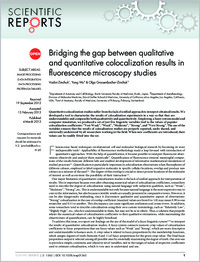Bridging the gap between qualitative and quantitative colocalization results in fluorescence microscopy studies
- Zinchuk, Vadim Department of Anatomy and Cell Biology, Kochi University Faculty of Medicine, Kochi, Japan
- Wu, Yong Department of Anesthesiology, Division of Molecular Medicine, David Geffen School of Medicine, University of California at Los Angeles, USA
- Grossenbacher-Zinchuk, Olga Unit of Anatomy, Faculty of Medicine, University of Fribourg, Switzerland
-
04.03.2013
Published in:
- Scientific Reports. - 2013, vol. 3, p. 1365
English
Quantitative colocalization studies suffer from the lack of unified approach to interpret obtained results. We developed a tool to characterize the results of colocalization experiments in a way so that they are understandable and comparable both qualitatively and quantitatively. Employing a fuzzy system model and computer simulation, we produced a set of just five linguistic variables tied to the values of popular colocalization coefficients: “Very Weak”, “Weak”, “Moderate”, “Strong”, and “Very Strong”. The use of the variables ensures that the results of colocalization studies are properly reported, easily shared, and universally understood by all researchers working in the field. When new coefficients are introduced, their values can be readily fitted into the set.
- Faculty
- Faculté des sciences et de médecine
- Department
- Département de Médecine
- Language
-
- English
- Classification
- Biological sciences
- License
- License undefined
- Identifiers
-
- RERO DOC 31895
- DOI 10.1038/srep01365
- Persistent URL
- https://folia.unifr.ch/unifr/documents/302981
Statistics
Document views: 72
File downloads:
- gro_bgb.pdf: 202
